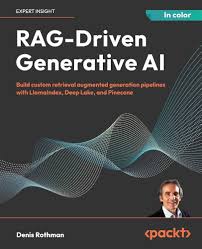RAG-Driven Generative AI: A Comprehensive Guide
Introduction
Retrieval-Augmented Generation (RAG) is a powerful technique that enhances the capabilities of generative AI models by integrating them with external knowledge sources. By combining the strengths of large language models (LLMs) with the accuracy and relevance of factual information, RAG systems produce more informative, comprehensive, and reliable outputs.
How RAG Works
- Document Retrieval: RAG systems utilize a document retrieval system to identify relevant information from a knowledge base.
- Embedding and Indexing: Documents are transformed into numerical representations (embeddings) and indexed in a vector database.
- Query Processing: When a user query is received, it's transformed into a query embedding.
- Similarity Search: The query embedding is compared to the document embeddings to identify the most relevant documents.
- Contextual Understanding: The retrieved documents are fed to the LLM, providing it with context and factual information.
- Response Generation: The LLM generates a response based on the query and the retrieved context.
Benefits of RAG
- Improved Accuracy: By grounding responses in factual information, RAG systems can reduce hallucinations and provide more accurate answers.
- Enhanced Relevance: RAG models can tailor responses to specific queries and contexts, improving relevance and user satisfaction.
- Factual Consistency: By referencing external sources, RAG systems can ensure that responses are consistent with real-world facts.
- Domain Expertise: RAG systems can be trained on specific domains to provide expert-level responses.
Use Cases of RAG
- Customer Service: Powering chatbots and virtual assistants with accurate and informative responses.
- Content Generation: Automating the creation of content, such as product descriptions, marketing copy, and news articles.
- Research and Analysis: Assisting researchers in finding relevant information and generating insights.
- Education: Creating personalized learning experiences and providing intelligent tutoring systems.
- Healthcare: Analyzing medical records and providing personalized healthcare recommendations.
Challenges and Limitations
- Data Quality and Bias: The quality of the underlying data can significantly impact the performance of RAG systems.
- Model Complexity: RAG systems can be complex to build and deploy, requiring expertise in data engineering, machine learning, and natural language processing.
- Ethical Considerations: Ensuring the ethical use of RAG systems, including addressing biases and misinformation.
Future Directions
- Multimodal RAG: Combining text, images, and other modalities to enhance the richness of information.
- Real-time Knowledge Updates: Continuously updating the knowledge base to ensure the latest information is accessible.
- Explainable AI: Providing explanations for the generated responses to increase transparency and trust.
- Privacy and Security: Protecting sensitive information and addressing privacy concerns.
Conclusion
RAG-driven generative AI is a powerful tool with the potential to revolutionize various industries. By leveraging the strengths of LLMs and external knowledge sources, RAG systems can deliver more accurate, relevant, and informative responses. As the technology continues to evolve, we can expect to see even more innovative applications of RAG in the future.
References:
- RAG-Driven Generative AI by Denis Rothman
- NVIDIA Blog: What Is Retrieval-Augmented Generation (RAG)
- AI Magazine: How Retrieval Augmented Generation (RAG) Enhances Gen AI
By understanding the principles and applications of RAG, developers and businesses can harness its power to create intelligent and informative AI systems.



